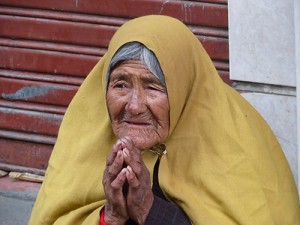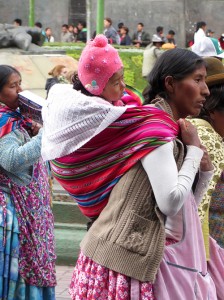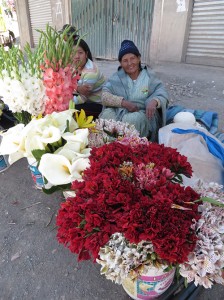
What is culture? I have come to think of it as the characteristics that a group of people might share. One source defines culture as “everything from language, religion, cuisine, social habits, music and arts” that a particular group of people might have in common. One of the reasons Bolivia is so beautiful is because it is overflowing with culture. It has strong indigenous roots that are very evident. For me, the most obvious difference culturally between Bolivia and the United States is the language. The most common language in Bolivia is Spanish, but there are three other very prominent languages: Guarani, Aymara, and Quechua. These indigenous languages are far from eradicated and the markets of La Paz buzz with these unfamiliar words that are drastically different from Spanish. Supposedly there are over thirty different languages spoken in Bolivia but these four seem to be the most used. Through working in the hospitals I was exposed to more of the indigenous languages, especially with people who had traveled to the hospital  from “el campo” (literally meaning the farm but in reference to more rural areas outside of the city). One difference between Spanish and English is that Spanish has both a formal and informal way of conjugating that I find very respectful. It makes it easier to address someone who is older or who you don’t know in a way that feels very polite.
from “el campo” (literally meaning the farm but in reference to more rural areas outside of the city). One difference between Spanish and English is that Spanish has both a formal and informal way of conjugating that I find very respectful. It makes it easier to address someone who is older or who you don’t know in a way that feels very polite.
The next most obvious cultural difference for me is the clothing. Having lived in La Paz, I was amazed at the combination of people in traditional and modern dress. The streets were full with people bustling off to work; men in full suits with ties and women in pencil skirts and high heels. However the markets of La Paz are full of Cholitas: the women who wear the traditional long “pollera” skirts which are colorful and voluminous multilayered skirts that reach the ankle. The women often wear beautiful blouses and embroidered shawls. They also use “aguayos”, colorful woven blankets for everything! They carry their babies on their backs in aguayos, as well as carry everything else: sticks, vegetables from the market etc. The women also wear these tiny little bowler hats that are so small they really just sit on top of their heads. I learned that the hats are a way of displaying their marital status depending on how the hat is situated, whether it tilts to the left, to the right, or is in the center. The hair is worn in two braids that often reach all the way down their backs. I learned upon my arrival to Tarija however, that what I assumed was the traditional clothing throughout Bolivia, actually varies by region. Tarija, which has a far more temperate climate than the high altitude city of La Paz, the polleras are very short and only reach about mid-thigh or to the knee. The word Chollita, or Chollito is also considered offensive in Tarija because here the traditional indigenous people are known as Chapacos (men), or Chapacas (women). Santa Cruz, another large city, has its own distinct style as well. The traditional clothing of the men is less of a display compared to the brilliant colors that the women don, but it usually includes a hat, pants and a white shirt, and some men wear a poncho.
While these are the more surface level differences in culture, there are also many differences in the social habits of Bolivians compared to the United States. I also observed that there are differences in the priorities that people have. First of all, I would like to discuss the difference in punctuality, or lack of it. I never realized how engrained it is in the North American culture to be punctual. It is just common knowledge that if you are supposed to be somewhere at a decided time, you are expected to be there on time or early otherwise it is considered rude. It is entirely the contrary here. If a party starts at 6:00 pm, people will most likely show up at 9:00 pm. While a party is obviously a less formal example, but I was shocked to say the least when I showed up at the hospital at 7:30 am as I was told to do, and the doctor didn’t arrive… for three hours. I was extremely annoyed a first but came to realize that this is just a part of the culture here. After this happened many other times I realized that punctuality is of little importance. Then I was told it can even be considered rude to show up on time to and even such as a party! Fifteen to thirty minutes late is far more polite. This just shows how culture can easily create misinterpretations. What I don’t like, however, is how some things really are on time (such as busses) and other hospital rotations I had. The Doctors said be there at eight and they actually meant on the dot. The issue is, there is no way to know when to be on time and when to be fashionably several hours late!
Another observation I had about the culture of Bolivia, as well as other countries I have visited in Latin America, is the importance of family. The whole life is centered around family. In the U.S., kids are expected to fly the coop right around age 18 and go off to college, get a real job and move out of their parents’ house. People who still live with their parents into their twenties oftentimes reluctantly admit it with a hint of embarrassment. In a culture where independence is viewed very highly, it might be interpreted as laziness or lack of motivation and people often assume that there must be a reason that said adult hasn’t moved out yet. It is extremely common in the U.S. for kids to venture out once they  finish high school. Some choose to go to a college far away from their hometown or move to a new state to prove their independence or to “get some space”. In Bolivia, it is the opposite once again. Kids often will stay with their parents, throughout their time in the University, or while working, into their mid-twenties, or often times until they decide to marry. Even then, they will probably not move too far; maybe the house next door, or to a different floor in an apartment complex, or maybe a ten minute drive. The point is that families stay close and visit often. The grandparents don’t get to see their grandkids once a year; they probably see them several times per week. So far I have lived with two families in Bolivia, and both families live within walking distance of their parents as well as their brothers and sisters. Where I am living currently, at least one family member comes by the house every day. Each Sunday, the whole family goes over to the grandparents’ house for a barbeque. Personally, I love the closeness of the families here. While at times it may seem suffocating, in general it is a wonderful support system for raising children as well as caring for the elders. The elderly don’t just get left alone which is often the case in the U.S, or put into a nursing home, they are cared for by their children and family. Nannies are pretty unheard of here because there is so much help from family members.
finish high school. Some choose to go to a college far away from their hometown or move to a new state to prove their independence or to “get some space”. In Bolivia, it is the opposite once again. Kids often will stay with their parents, throughout their time in the University, or while working, into their mid-twenties, or often times until they decide to marry. Even then, they will probably not move too far; maybe the house next door, or to a different floor in an apartment complex, or maybe a ten minute drive. The point is that families stay close and visit often. The grandparents don’t get to see their grandkids once a year; they probably see them several times per week. So far I have lived with two families in Bolivia, and both families live within walking distance of their parents as well as their brothers and sisters. Where I am living currently, at least one family member comes by the house every day. Each Sunday, the whole family goes over to the grandparents’ house for a barbeque. Personally, I love the closeness of the families here. While at times it may seem suffocating, in general it is a wonderful support system for raising children as well as caring for the elders. The elderly don’t just get left alone which is often the case in the U.S, or put into a nursing home, they are cared for by their children and family. Nannies are pretty unheard of here because there is so much help from family members.
A huge part of culture is the food. The eating habits in Bolivia took some getting used to. Breakfast is light; lunch is the major meal of the day. This is the meal that the entire family eats together if possible much like dinner in the United States. The children return home from school, the parents come home from work, and everyone eats together. It almost always starts with some type of soup and then is followed by a main course that almost always includes meat, accompanied by rice or noodles and maybe vegetables or a grain. After lunch there is a siesta, a time to rest and digest a little, or take a brief nap. Dinner is usually the same as breakfast. It is often referred to as “tecito”. Typically tecito is coffee or tea and a snack such as some bread with cheese and meat, a pastry, or leftovers from lunch. I learned while I was in La Paz that the high elevation of about 12,000 feet, slows down the digestion a lot and this is one of the reasons that they are very conscientious about not eating anything too heavy late in the day in La Paz. While talking with a Bolivian friend one day about culture one day, we began discussing traditional foods. She rattled off about ten different traditional Bolivian dishes, several of which were specific to Tarija. When she asked me about what the traditional foods are in the United States, I was rather stumped. I tried to explain that we are a fairly young country as well as a huge melting pot of cultures. We have some foods such as the hamburger that might be considered “American food” or maybe fried chicken in the south, but in reality it can’t even be compared with the distinct culture that Bolivia has surrounding food.
While there are many aspects of the culture that I love, the most challenging for me is the fact that Bolivia remains a very machismo society. For example: I was living with a family, and every morning the mother would wake up early and bring her husband and her son breakfast in bed. Her son, age five, would order her around. After lunch, which he would hardly eat, he would always ask for yogurt or bread and jam, and she would always get it for him. She did all of the cooking, would serve everyone and then her husband would take a siesta while she would then clean everything. She did all the laundry, all the cooking, all the cleaning and it is clear that these are the chores that are expected of women  here. Not to say that the husband was at all a bad person, he was wonderful, but I could tell that he had been raised in a similar way by his mother and was accustomed to not helping with these things. On the other hand, his wife was similarly raised learning what is expected of the wife. This is a very minor example, but there is also a huge amount of domestic violence against women in Bolivia. Many men feel that they need to show their superiority over their wives maybe? I really don’t know, but it is certainly a huge problem here. Personally, I have noticed how often men feel that they need to cat call or whistle at women. Even much older men will say some type of comment as I walk bye or blatantly stare.
here. Not to say that the husband was at all a bad person, he was wonderful, but I could tell that he had been raised in a similar way by his mother and was accustomed to not helping with these things. On the other hand, his wife was similarly raised learning what is expected of the wife. This is a very minor example, but there is also a huge amount of domestic violence against women in Bolivia. Many men feel that they need to show their superiority over their wives maybe? I really don’t know, but it is certainly a huge problem here. Personally, I have noticed how often men feel that they need to cat call or whistle at women. Even much older men will say some type of comment as I walk bye or blatantly stare.
Over all, experiencing new cultures is absolutely fantastic in my opinion. It is a way to see how other people in the world live, eat, think, work, play and everything in between. More than anything, it requires an open mind. As a semi-vegetarian in the United States, I have now tried cow heart, cow tail, and eaten soup with chicken feet in it. I have gone salsa dancing, watched Cholita wrestlers, gone to a choir performance and run two races to raise money for children with cancer. I have worked in eight hospitals and clinics, and lived with two different families. I absolutely love meeting new people, talking with them and learn about how they live their lives. One of the most important lessons that traveling has taught me is that that just because I was raised one way and carry my own cultural baggage with me, does not mean that is the right, or the wrong, way to live. Different does not mean wrong and it will change the entire experience of being in a foreign country if you judge the way that other people live.
Source: http://www.livescience.com/21478-what-is-culture-definition-of-culture.html